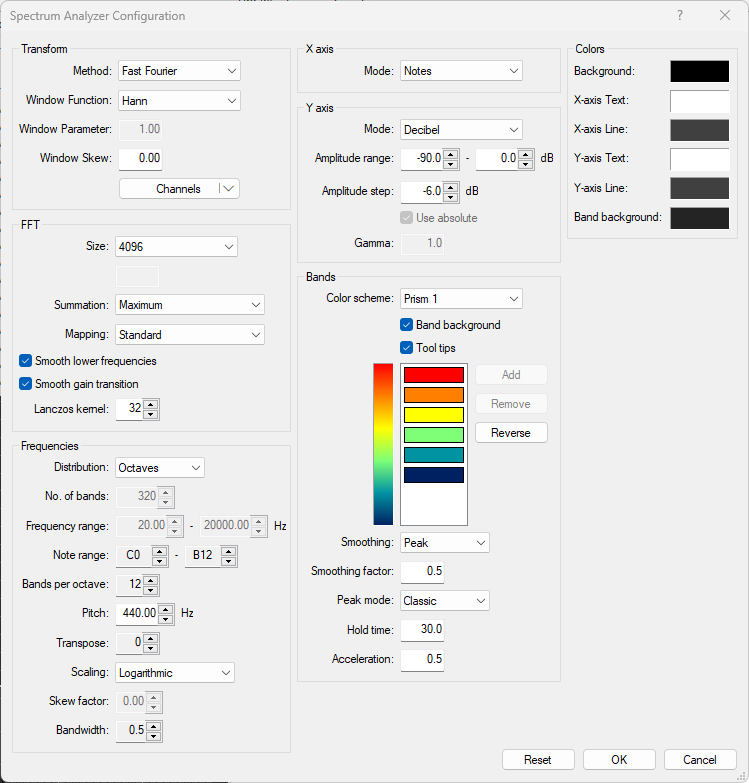Foobar2000:Components/Spectrum Analyzer (foo vis spectrum analyzer): Difference between revisions
No edit summary |
No edit summary |
||
| Line 12: | Line 12: | ||
| stable_release = | | stable_release = | ||
| stable_release_date = | | stable_release_date = | ||
| preview_release = 0.1. | | preview_release = 0.4.1.1 | ||
| preview_release_date = {{start date and age|2023|11| | | preview_release_date = {{start date and age|2023|11|29}} | ||
| foobar2000_architecture = x86 32-bit, x86 64-bit | | foobar2000_architecture = x86 32-bit, x86 64-bit | ||
| foobar2000_minimum = 2.0 | | foobar2000_minimum = 2.0 | ||
| Line 30: | Line 30: | ||
[[File:Spectrum_Analyzer_Configuration.png]] | [[File:Spectrum_Analyzer_Configuration.png]] | ||
'''Summation''' | == Transform == | ||
'''Method''' | |||
Allows you to the selected the Time to Frequency domain transform. Currently Fast Fourier (FFT) and Constant-Q (CQT) transforms are implemented. | |||
== FFT == | |||
Groups the parameters that influence the Fast Fourier transform. | |||
'''FFT Size''' | |||
Specifies the size of the FFT window as a number between 64 and 32768. | |||
Select ''Custom'' to specify a number that is not a power of 2. This will consume a lot more CPU power. | |||
Select ''Sample rate based'' to specify the size as a duration. F.e. 100ms of a track sampled at 44.1kHz will result in an FFT window of 4410 samples. | |||
'''Summation''' | |||
Determines which method is used to sum the coefficients of FFT. | |||
Minimum | Minimum | ||
| Line 46: | Line 64: | ||
'''Smooth gain transition''' | '''Smooth gain transition''' | ||
'''Lanczos kernel''' | '''Lanczos kernel''' | ||
Determines the size of the Lanczos kernel. The kernel is used to create a smooth transition between the FFT coefficients resulting in a visual pleasing result. | |||
'''Distribution''': Determines which parameters are used to generate the frequency bands. | '''Distribution''': Determines which parameters are used to generate the frequency bands. | ||
Revision as of 16:51, 29 November 2023
This article is a stub. You can help the Hydrogenaudio Knowledgebase by expanding it.
Experimental component
This component is considered an early prototype and it is under development as it was released as an early access. Bugs and issues with this component are expected and currently it has no CUI support.
| Spectrum Analyzer | |
|---|---|
 foo_vis_spectrum_analyzer | |
| Developer(s) | |
| Release information | |
| Preview release | 0.4.1.1 (November 29, 2023; 2 years ago) |
| foobar2000 compatibility | |
| Architecture | x86 32-bit, x86 64-bit |
| Minimum version | 2.0 |
| UI module(s) | Default UI |
| Additional information | |
| Use | Visualization |
| View all components | |
A recreation of Musical Spectrum component for foobar2000 v2.x and 64-bit versions.
Configuration
Right-click on the component window and select Configure from the context menu to open the configuration dialog.
Transform
Method
Allows you to the selected the Time to Frequency domain transform. Currently Fast Fourier (FFT) and Constant-Q (CQT) transforms are implemented.
FFT
Groups the parameters that influence the Fast Fourier transform.
FFT Size
Specifies the size of the FFT window as a number between 64 and 32768.
Select Custom to specify a number that is not a power of 2. This will consume a lot more CPU power. Select Sample rate based to specify the size as a duration. F.e. 100ms of a track sampled at 44.1kHz will result in an FFT window of 4410 samples.
Summation
Determines which method is used to sum the coefficients of FFT.
Minimum Maximum Sum Residual Mean Square (RMS) RMS Sum Average Median
Smooth lower frequencies
Smooth gain transition
Lanczos kernel
Determines the size of the Lanczos kernel. The kernel is used to create a smooth transition between the FFT coefficients resulting in a visual pleasing result.
Distribution: Determines which parameters are used to generate the frequency bands.
Linear: Generate frequency bands based on the frequency parameters. Octaves: Generate frequency bands based on the note parameters. AveePlayer: Generate frequency bands used by AveePlayer.
No. of bands: Number of frequency bands to generate (2 to 512)
Frequency range: Frequency of the first and last band, 0Hz to 96000Hz.
Note range: Number of the first and last note. (C0 = 0, C1 = 12, ...), 0 to 143 (12 octaves)
Bands per octave: Number of bands per octave (1 to 48)
Pitch: Tuning pitch (A4 = 440.0Hz), 0Hz to 96000Hz.
Transpose: Detuning offset (-24 to 24)
Scaling: Determines which frequency scaling function is used.
Linear Logarithmic Shifted logarithmic Mel (AIMP) Bark Adjustable Bark ERB Cams Hyperbolic Sine Nth Root Negative exponential Period
Skew factor
Bandwidth: 0.0 to 64.0
X axis: Determines which X axis to display.
Bands: Center frequency of a band, every 10 bands. Decades: Fixed frequency range Octaves: Frequency of the C note of each octave Notes: C note of each octave
Y axis: Determines which Y axis to display.
Decibel scale Logarithmic
Color scheme: Specifies the color scheme used to render the spectrum.
Solid color (Not configurable yet) Custom color scheme (Not implemented yet) Prism 1 Prism 2 Prism 3 foobar2000 foobar2000 Dark Mode
Smoothing: Specifies how the spectrum will be smoothed over time.
Average Peak
Smoothing factor: Specifies the strength of the smoothing (0.0 to 1.0)
Peak mode: Specifies how the peak indicators are rendered.
None Classic Gravity AIMP Fade Out
Hold time
Acceleration
External links
- Spectrum Analyzer (foo_vis_spectrum_analyzer) on
 foobar2000.org
foobar2000.org - Discussion topic on
 hydrogenaudio
hydrogenaudio
See also
- Frequency bands spectrum analyzer using either FFT or CQT on CodePen (which this component is based on)

